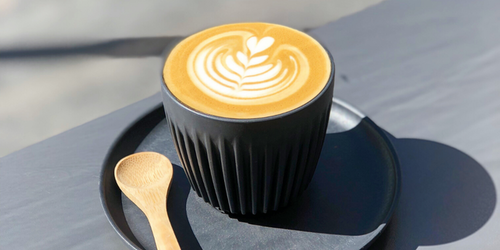How a Reusable Cup can Help you in Plastic-Free July
Posted by Aless on 14th Jul 2025
What began as a small initiative, Plastic-Free July is now a fast-growing global movement driving meaningful action year after year. Across the world more individuals, businesses, and communities are taking meaningful steps to reduce their reliance on single-use plastics and adopt more sustainable habits. But beyond the feel-good factor, why does swapping out a disposable coffee cup really matter?
Choosing a reusable cup isn't only a symbolic gesture but rather a commitment to long-term environmental responsibility. It’s a practical and impactful decision that supports sustainability while also saving money over time. From reducing your personal environmental footprint to selecting a cup that suits your routine, there are countless reasons to make the switch. Get ready to raise a glass (a reusable one, of course!) to a more sustainable you.
The Goal of Plastic-Free July

Plastic-Free July is one of the world’s largest environmental campaigns focused on reducing single-use plastic waste. Originating in Australia, this annual movement encourages individuals to refuse single-use plastics throughout July and attempt to continue those habits well beyond the month. In 2025, the Plastic Free July initiative inspired over 100 million participants across 190 countries, demonstrating its widespread reach and drive to accomplish change. But Plastic-Free July is more than just a 31-day challenge, it's designed to spark long-term behaviour change by raising awareness of the environmental damage caused by disposable plastics.
The campaign’s core mission is to drastically reduce single-use plastic waste and promote sustainable behaviour that can be maintained forever. To support this, Plastic-Free July provides practical resources tailored for individuals, schools, businesses, and organisations, while sharing what others do to accomplish this challenge, creating a holistic, community-driven approach to plastic reduction.
As Jeb Berrier, creator of the documentary Bag It, powerfully points out: “Why are we making products intended to be used for minutes from materials that last for centuries?” This simple question surrounding planned obsolescence underscores the unsustainable nature of our current habits and reinforces the urgent need to embrace a greener approach for the future.
The Effects of Single-Use Plastics
The environmental consequences of our reliance on single-use plastics are both far-reaching and deeply damaging. These items, designed for convenience and typically used for just minutes, can persist in the environment for hundreds of years. Over time, they break down into microplastics that infiltrate soil, waterways, and even the food chain, posing ongoing threats to both ecosystems and human health.
One of the most devastating impacts of single-use plastic is marine pollution. According to the United Nations, over 11 million metric tons of plastic enter the ocean each year, a figure projected to triple by 2040 if no action is taken. This pollution consequently harms countless marine animals through ingestion, suffocation, and entanglement.
Marine species such as turtles, seabirds, whales, and fish are particularly vulnerable, as they often mistake floating plastic debris for food, such as jellyfish or small fish, which leads to internal blockages, malnutrition, or toxic exposure from chemicals attached to the plastic. In other cases, animals become entangled in items like plastic bags, six-pack rings, or discarded fishing nets, restricting their movement, causing severe injury, or leading to drowning. WWF has estimated that plastic pollution kills 100,000 marine mammals every year, with 81 out of 123 marine mammal species known to have eaten or been entangled in plastic. This is particularly harmful to endangered animals like sea turtles, with 2 species of sea turtles being classified as critically endangered.
The problem extends far beyond disposal. The production of single-use plastics also comes at a steep environmental cost. It requires large amounts of fossil fuels, water, and energy, contributing significantly to greenhouse gas emissions. According to a 2019 report by the Centre for International Environmental Law, the full life cycle of plastic, from production to disposal, could generate up to 2.8 gigatons of CO2 emissions per year by 2050, equivalent to nearly 615 coal-fired power plants.
Plastic-Free July emerged as a proactive solution to combat the growing environmental threat posed by single-use plastics. By inspiring individuals and communities to take meaningful steps together, the movement encourages ongoing commitment to reducing plastic consumption and fostering a healthier, more sustainable environment.
Environmental Impact of using a Reusable Cup

One of the most compelling reasons to switch to a reusable cup is its large role in reducing waste and pollution, which directly supports the goals of Plastic-Free July. Globally, it is estimated that over 500 billion disposable cups are used each year, of which around 99% of these are not being recycled due to their plastic lining. As a result, millions of these cups end up in landfills or as litter, contributing to environmental degradation. Therefore, opting for reusable cups each time you drink can reduce this strain, placing less stress on natural ecosystems and limiting the required production to create single-use cups. In October 2022, Zero Waste Scotland determined if reusable cups replaced single-use cups, carbon emission could fall by 69%, greatly reducing greenhouse emissions.
While the production of reusable cups initially demands more resources like materials and energy, research shows that this upfront environmental cost is offset with consistent use. Studies indicate that a reusable cup needs to be used between 20 and 100 times to offset its environmental footprint compared to disposable alternatives. This range varies depending on factors like material, manufacturing processes, and disposal methods, but the message remains clear: repeated use dramatically reduces overall environmental impact.
Choosing a durable, insulated cup with features such as double-walled construction can further improve sustainability. These designs maintain beverage temperatures for longer periods, reducing the need for reheating or recooling, which saves additional energy otherwise needed to return your drink to its optimal temperature. For example, well-insulated cups can keep drinks hot for up to 12 hours or cold for up to 24 hours, making them practical for daily use and decreasing energy consumption related to temperature control.
Adopting reusable cups sends a strong societal message and can catalyse broader environmental change. If even a fraction of disposable cup users worldwide switched to reusables, it could prevent billions of cups from entering the waste stream annually, drastically reducing landfill volume and cutting carbon emissions associated with manufacturing and waste management.
Financial Savings
Other environmental perks, embracing a reusable cup can also lead to vast financial savings. Many cafes, in an attempt to encourage eco-friendly behaviour, offer discounts to customers who bring their own cups. These discounts, typically ranging from 20 to 50 cents, might seem small individually, but they add up considerably over time making a noticeable difference over the year.
The initial cost of a reusable cup is quickly neutralised by these discounts and the elimination of disposable cup costs. Some brands even offer immediate financial incentives that consumers can enjoy immediately or offer services that allow you to swap your old reusable travel mug for a new one at participating cafes like Huskee with HuskeeSwap. By investing in a reusable cup, you're making a financially savvy decision that benefits both your wallet and the environment.
Choosing the Right Reusable Cup: Features to Consider
The benefits of reusable cups extend beyond environmental and financial considerations, they also uplift the overall beverage experience.
Material Choices
Stainless steel: Known for its durability and excellent insulation, stainless steel resists imparting flavours and is ideal for long-term, everyday use.
Glass: Offers a pure, clean taste and is easy to clean, though its fragility makes it more prone to breaking.
Ceramic: Provides a premium feel and retains heat well, but is more susceptible to chipping or cracking over time.
Composite materials (e.g. coffee husk): A sustainable option made from repurposed waste, such as the HuskeeCup, which is BPA-free, dishwasher safe, stackable, and offers good insulation
Choosing the right material ultimately depends on your priorities, whether that’s durability, taste, insulation, or sustainability—with user reviews often reflecting personal preferences and perceived benefits.
Capacity and Insulation
Selecting the right cup capacity comes down to your daily coffee habits and how portable you need your cup to be. If you’re someone who enjoys larger coffees, a cup with a capacity of 16oz or more is ideal to avoid frequent refills. On the other hand, if you prefer smaller beverages or need something compact for commuting, a 6oz cup may be a better fit.
Insulation is another key factor, especially if you want your drink to stay hot or cold for extended periods. Double-walled designs are particularly effective, helping maintain optimal temperatures while also protecting your hands from heat. For instance, Huskee's HuskeeSteel reusable cup has a double-wall insulation to keep drinks hot or cold for extended periods improving the overall drink experience. Whether you're a coffee connoisseur or simply enjoy a refreshing beverage on the go, a reusable cup can elevate your drinking experience.
Design and Portability: The Perfect Travel Companion
Design and portability are vital considerations, especially if you plan to use your reusable cup on the go. Cups with leak-proof lids help prevent spills during commutes, while ergonomic designs and comfortable grips make them easier to carry throughout the day. For those who travel frequently or have limited luggage space, compact or stackable designs, such as HuskeeCup, offer a practical solution without compromising on style or function. Before making a purchase, it’s important to consider how the cup’s design aligns with your daily routine and whether it boosts your overall coffee experience while you're on the move.
Making a Commitment to a Plastic-Free Future
Embracing a reusable cup is a simple yet powerful step towards reducing plastic waste and creating a more sustainable future. By choosing to reuse, you actively contribute to environmental preservation, save money, and improve your beverage experience. As we've explored, innovative product options like the HuskeeCup are making sustainable lifestyle changes more accessible and appealing.
This Plastic-Free July, let's all commit to ditching single-use cups and embracing reusable alternatives. By taking immediate action, you can become part of a global community dedicated to reducing plastic waste.


